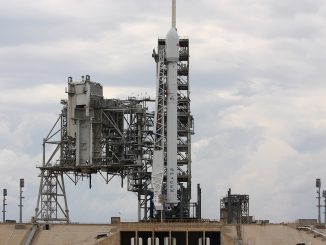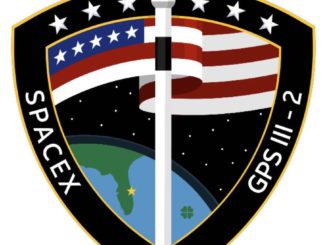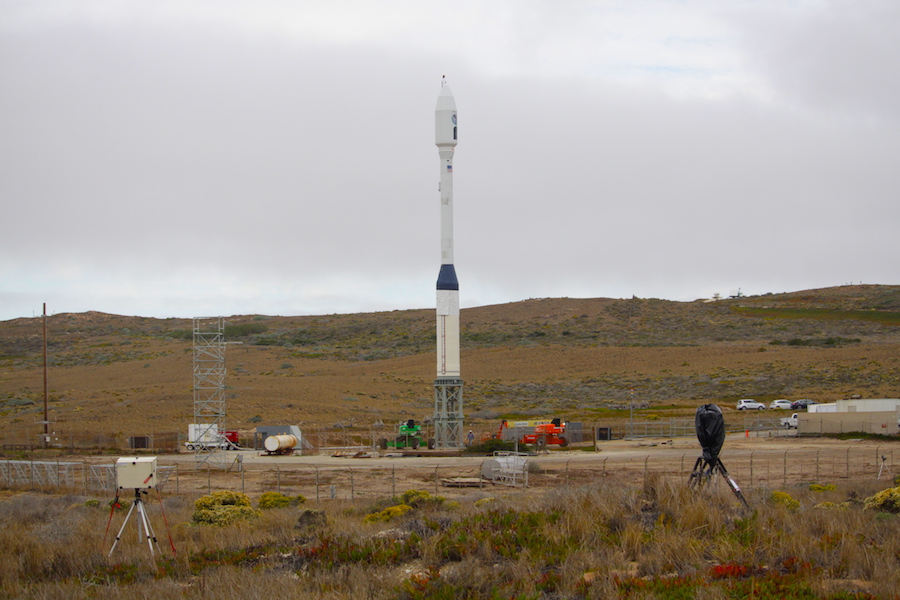
More than six years after back-to-back failures left the Taurus rocket with an uncertain future, a redesigned version of the launcher sporting a new name is set to loft 10 small Earth-imaging satellites into orbit Tuesday from Vandenberg Air Force Base in California.
Now dubbed the Minotaur-C, the four-stage rocket built and operated by Orbital ATK is standing on a launch pad overlooking the rugged Pacific coastline, ready for a 10-minute trip into orbit set to begin at 2:37 p.m. PDT (5:37 p.m. EDT; 2137 GMT) Tuesday, the opening of a 30-minute window.
Ground crews spent the last few weeks assembling the rocket at Space Launch Complex 576E, an austere launch pad at Vandenberg that was last used in March 2011 on the most recent Taurus flight.
That flight ended in failure, when the Taurus rocket’s payload shroud clung to the vehicle as it climbed into space, preventing NASA’s Glory climate research satellite from reaching orbit. A similar payload fairing failure doomed the previous Taurus flight in 2009, resulting in the loss of another NASA-funded Earth science mission.
The payload fairing was supposed to drop away from the top of the rocket in a clamshell-like fashion a few minutes after liftoff.
The mishaps prompted NASA to switch the launch of the Taurus rocket’s sole remaining mission to another rocket, leaving the light-class launcher without an assured future.
But Orbital ATK, then known as Orbital Sciences, revamped the Taurus program in a bid to keep the launcher active, serving a growing slice of the commercial satellite marketplace that has few good U.S. launch options, at least with rockets that have flown before.
“The elephant in the room is that this is a return-to-flight after two failures,” said John Brunschwyler, Orbital ATK’s Minotaur-C program manager. “We have a significant number of people on the team who were part of those launch campaigns back in 2009 and 2011. Getting back into it, it’s surprisingly fresh and people are very motivated.”
The Minotaur-C rocket will place six SkySat spacecraft into orbit 310 miles (500 kilometers) above Earth to record high-definition video and high-resolution optical still imagery of locales around the world.
Four smaller Dove CubeSats, known as Flock 3m, will also hitch a ride on the rocket, joining the SkySats in a growing fleet of Earth-observing satellites owned by Planet, a San Francisco-based company whose mission is to image the entire globe every day.
Built by Space Systems/Loral, each of the SkySats is about the size of a dorm room refrigerator — measuring 2.5 feet by 2 feet by 2 feet (95 by 60 by 60 centimeters) — and weighs around 242 pounds (110 kilograms). The Doves are built in-house by Planet and are roughly the size of a shoebox.
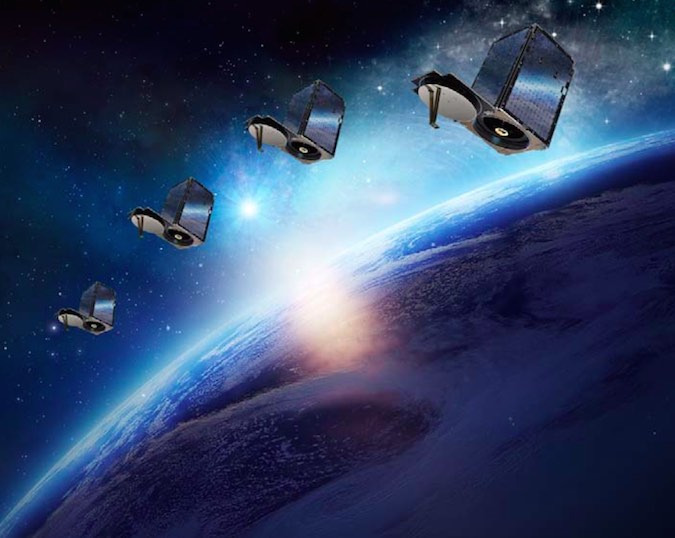
The Minotaur-C rocket launching Tuesday has a different fairing than the Taurus rockets launched in 2009 and 2011. The shroud spans 92 inches (2.3 meters) in diameter, wider than the fairings flown on the last two Taurus rockets.
Investigators probing both fairing failures could not settle on a definite cause, but in both cases, the two halves of the shroud remained on the rocket, weighing it down and keeping it from entering orbit.
The 92-inch fairing design has performed without fault on Orbital ATK’s Minotaur 4 rocket, most recently in August. While similar in design, its separation mechanism is not identical to the one on the smaller fairing.
“All of our missions receive an incredible amount of scrutiny and independent review,” said Phil Joyce, Orbital ATK’s vice president of small launch programs. “We did that twice again for this mission, (with) added layers of additional deep dives and other things not only on the fairing, which has been flight-proven on other vehicles … but everything about the changes that we made to the vehicle to take it from the Taurus to Minotaur-C.
“We feel really good about this launch coming up on Tuesday,” Joyce said in an interview with Spaceflight Now.
“So does that make it any less nerve-racking? No, but it’s exciting, and I think we’ve beaten back as many worries as we could have,” Brunschwyler said.
Changes from the Taurus XL rocket include modified avionics and guidance systems originally developed for Orbital ATK’s Minotaur 1 and Minotaur 4 boosters, which use decommissioned Minuteman and Peacekeeper missile motors.
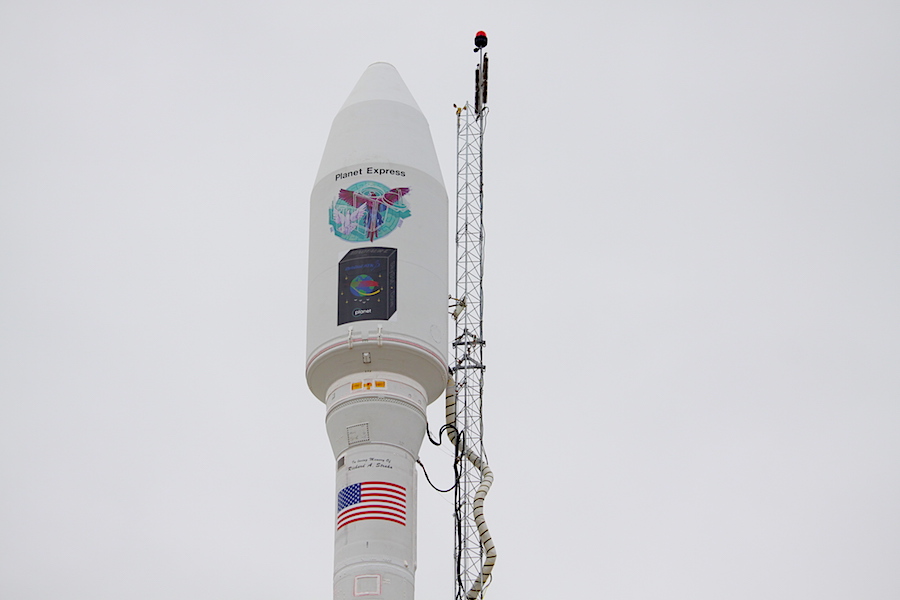
Officials said sharing engineering teams and components between the Minotaur, Minotaur-C and the company’s air-launched Pegasus rocket will reduce overhead costs.
“There are some Taurus components that remain in the system, but one of the reasons we changed the name was we’re going to a more common avionics between our Minotaur program, the Minotaur-C, and the Pegasus to maximize the commonality and to really drive down cost,” Joyce said. “That’s what we’re all about at Orbital ATK, is driving down the cost of our small space launch offerings, and this is a step on that road.”
Orbital ATK’s future in the commercial launch market, at least for now, could hinge on proving the Minotaur-C’s reliability and making the solid-fueled rocket affordable.
U.S. law prohibits Orbital ATK from selling Minotaur 1 and Minotaur 4 launch services to commercial customers because they use retired missile parts. Proponents of the law say lifting of the ban would give an unfair advantage to companies like Orbital ATK and slow development of new commercial rockets by undercutting their costs.
Orbital ATK has pushed to end the ban, which keeps the Minotaur 1 and Minotaur 4 rockets walled off from the commercial market and available only to launch U.S. military payloads.
India’s Polar Satellite Launch Vehicle has netted new business in recent years, sometimes launching dozens of small satellites for companies and universities based in the United States, Europe and elsewhere
Europe’s Vega rocket, marketed by Arianespace, has also found a niche in launching small-sized Earth observation satellites, often for governments without a vibrant domestic launch capability, such as Vietnam, Peru, Morocco and Kazakhstan.
Orbital ATK wants to compete for those launch opportunities.
The Minotaur rockets employing retired missile motors are less expensive than the Minotaur-C, even with Orbital ATK’s latest cost reduction measures, Joyce said.
“We do see this part of the market as potentially very significant, so we’re looking and continuing to evolve the Minotaur-C and its propulsion system to drastically reduce the cost of the classic Taurus to what we’re going to be able to offer going forward,” Joyce said.
Corporate executives touted the 2015 merger of Orbital Sciences and ATK as another way to achieve cost savings.
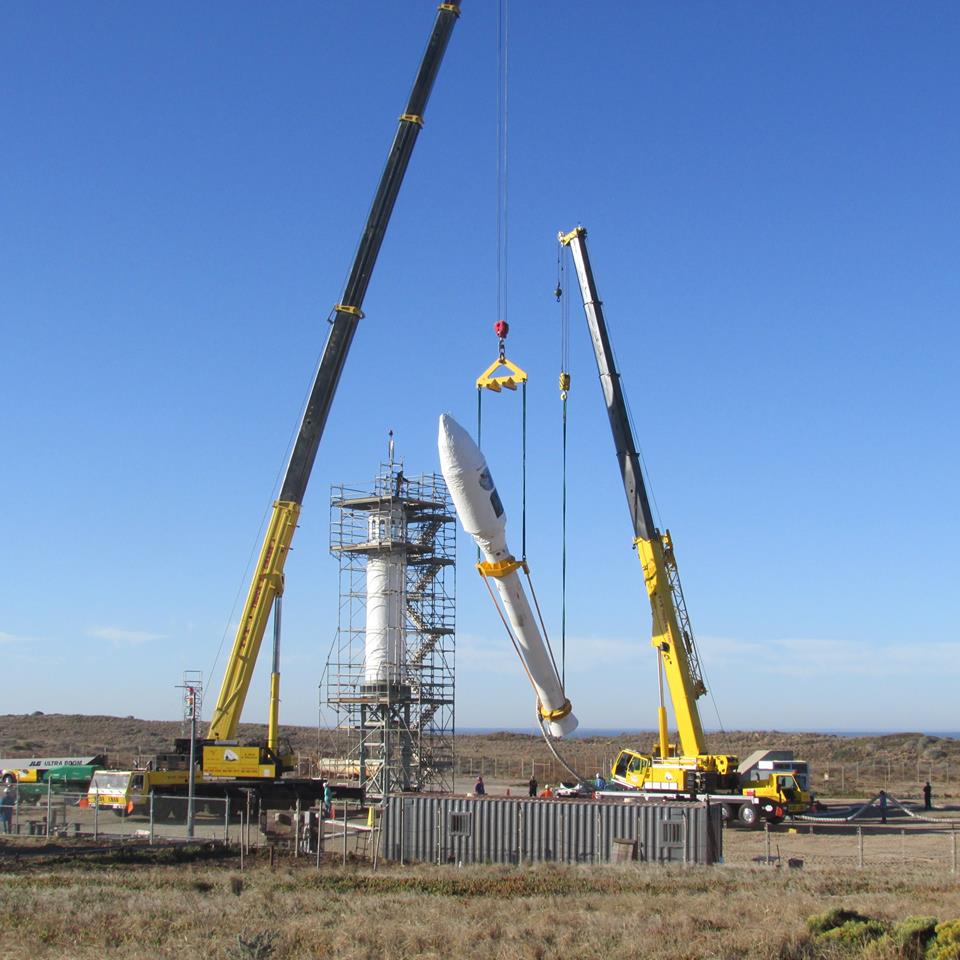
The Minotaur 1 uses two booster stages from decommissioned Minuteman missiles, and the Minotaur 4 family is powered by three rocket motors from the Peacekeeper missile program. Both versions of the Minotaur have commercially-produced upper stage motors to place satellites in orbit.
The Minotaur-C’s first stage — called Stage 0 by Orbital ATK — is a Castor 120 rocket motor that is the commercial equivalent of a Peacekeeper first stage. Derivatives of Orbital ATK’s Orion 50 and Orion 38 rocket motors will do the rest of the job of climbing into orbit.
The commercially-produced rocket motors are more expensive to prepare for a launch than government-furnished missile components. Government oversight officials have conducted preliminary studies of how retire missile stages could be turned over to commercial launch providers, examining different ways to gauge the cost of the government-owned motors and charge companies for their use.
Orbital ATK has sold recent Minotaur 1 and Minotaur 4 missions to the U.S. Defense Department for less than $30 million. While financial details for Tuesday’s mission have not been disclosed, data published in a Government Accountability Office in August pegged a Minotaur-C launch at a cost between $40 million and $50 million.
“We’re not going to get down in the price range of Minotaur ICBM launch vehicles with Minotaur-C, but having said that, a lot of the common avionics and other processes that we’re starting to apply to all of our launch vehicles will bring down the cost of all of those,” Joyce said. “The Minotaur launch vehicle with the propulsion systems provided the government for government payloads has that advantage.”
Planet has already launched satellites on the Minotaur-C’s would-be competitors like the PSLV, Vega and the Russian Soyuz rocket. The company’s contract with Orbital ATK was inherited from Terra Bella, which Planet acquired from Google earlier his year.
Terra Bella, formerly known as Skybox Imaging, started the SkySat satellite program, while Planet’s heritage lies in the Dove CubeSat constellation.
All the SkySat and Dove satellites launched to date have flown as secondary payloads, either aboard a rocket carrying larger spacecraft or as a piggyback on supply ships heading to the International Space Station.
“This is a launch contract that we inherited from originally Skybox, and then Terra Bella under Google, but for us to take over the final stretch, it’s been wonderful working with Orbital ATK,” said Mike Safyan, director of launch and regulatory affairs at Planet. “The level of professionalism, and all of the preparation activities and the level of attention that we get as a primary customer is quite different than when we’re riding in the back seat as we usually do.”
Small satellite owners like Planet would like to see more launch options for their spacecraft, particularly for dedicated rides. Several companies, such as Rocket Lab and Virgin Orbit, are working on light-class launch vehicles sized to haul up to several hundred pounds into low Earth orbit, but neither have successfully reached orbit.
Customers with satellites hitching a ride on a larger rocket are at the mercy of their co-passengers. While satellite owners can find reduced launch costs on a rideshare mission, they run the risk of delays, and launch brokers cannot put all of the payloads in their perfectly-desired orbit. It’s a tradeoff that challenges many satellite owners.
“One of the main advantages is control over schedule and control over the orbit, and that is a big deal for us,” Safyan said.
Most of Planet’s satellites are in sun-synchronous-type orbits that fly over imaging targets in the morning. The SkySats and Doves going up Tuesday will be positioned in orbits with afternoon coverage.
“Most remote sensing satellites, especially in optical, go into morning (orbits),” Safyan said. “For us to be able to say we want a special ride specifically to afternoon, which means that we further diversify our dataset from the rest of the competition, and to basically double the capacity of SkySats that we are flying, that’s a really big deal.”
At the request of Planet, the Minotaur-C rocket has been nicknamed “Planet Express,” a nod to the interplanetary delivery ship crewed by the main characters in the animated television series “Futurama.”
Fueled by a non-toxic “green” propellant blend based on ammonium dinitrimide, the SkySats will spread out in orbit and enter service within a few weeks after launch, Safyan said.
ECAPS, the Swedish company which builds the SkySat propulsion module, says the high performance green propulsion system offers better performance than conventional hydrazine maneuvering jets, and the units are easier to transport and prepare for launch.
The launch of six SkySats on Tuesday will be the biggest deployment of satellites with “green” propulsion in history, officials said.
“There are different operating modes that the SkySats can do,” he said. “They can target specific areas, or they can do more strip or area scanning, and they can do video. It’s a really flexible, powerful system. We’ve been really pleased with the ones already in orbit, and it’s going to be great to have six more.”
The SkySats collect imagery with resolution as high as 2.6 feet (80 centimeters), not as sharp as pictures from bigger satellites owned by companies like Airbus and DigitalGlobe. But the strength of the multi-satellite constellation is its revisit capability, allowing rapid refresh views of imaging targets around the world, and the video recording capability is a unique offering in the commercial remote sensing market.
Planet has launched more than 250 satellites since 2013, some of which have ended their missions. The company said last month that it receives imagery from 160 Dove satellites each day covering 131 million square miles (340 million square kilometers), twice the area of all of Earth’s land masses.
Space Systems/Loral is building at least eight more SkySats. Two of them will launch next year on a rideshare mission to sun-synchronous orbit on a SpaceX Falcon 9 rocket, and Planet is will finalizing launch arrangements for the other six.
It will take around 10 minutes for the Minotaur-C rocket to deliver the six SkySats and four Doves to orbit.
The first stage Castor 120 rocket motor will propel the 104-foot-tall (32-meter) vehicle off the pad at Vandenberg and guide it to the south, generating more than 400,000 pounds of thrust during a burn lasting nearly one-and-a-half minutes.
After burnout of the first stage, an Orion 50S XLT second stage motor will ignite at T+plus 1 minute, 25 seconds, to continue climbing into space. Ignition of the third stage Orion 50 XLT is programmed for T+plus 2 minutes, 51 seconds, followed by separation of the Minotaur-C’s payload fairing about seven seconds later at an altitude of 99 miles (160 kilometers)
The rocket will coast more than four minutes after burnout of the third stage motor. The Minotaur-C’s Orion 38 fourth stage is scheduled to fire at T+plus 9 minutes, 16 seconds, and complete its burn a little more than a minute later, concluding the powered phase of the mission.
The first four SkySats will release from their dispenser at 20-second intervals beginning at T+plus 13 minutes, 22 seconds, followed by separation of a bulkhead at T+plus 15 minutes, 22 seconds, to reveal the other two SkySats for deployment.
All six SkySats should be away from the rocket by T+plus 17 minutes, and the Dove CubeSats will separate in pairs before the 20-minute mark of the mission.
The Minotaur-C launch team will lose contact with the rocket when it passes out of range of a tracking station shortly before beginning the satellite separation sequence. Officials will confirm the final success of the launch when the SkySats pass over another ground antenna soon after deployment in orbit.
Email the author.
Follow Stephen Clark on Twitter: @StephenClark1.

